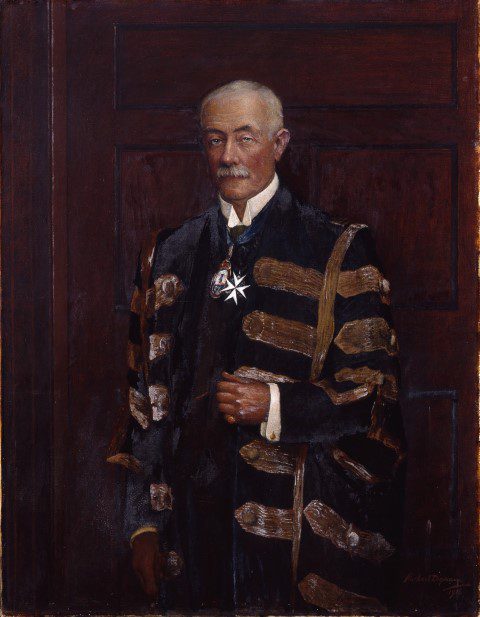Oladele Onada
Dublin, Ireland
 |
| Ephraim M. Cosgrave (1853 – 1928) With permission from W. Harriet |
Of the many physicians who originated from Ireland few were more eminent than Ephraim McDowell Cosgrave. Born into a family with a distinguished record in serving the Irish people, he was born in Dublin North and grew up with an interest in Georgian houses, Dublin maps, and photography.1-5 His parents were Alexander W. Cosgrave and Anna (nee McDowell), and he was named after his maternal grandfather, Ephraim McDowell.
He studied at Trinity College, Dublin, first chemistry and biology, then graduated in medicine in 1878. He taught biology to medical students at the Carmichael School of Medicine, then developed an interest in chest medicine and wrote many articles on tuberculosis. In 1889 he became physician and senior lecturer to the Whitworth Fever General Hospital, Drumcondra. There he prevented the closure of the hospital and its conversion to a Georgian church.
His private practice included the wife of the Duke of Leinster, Baroness Hermione Wilhelmina from Menton, France, who died of tuberculosis at the age of thirty-three. He championed tuberculosis control in Ireland, and in 1889 was promoted to professor of biology of the Royal College of Surgeons of Ireland. He continued to work closely with the Department of Health and Communicable Diseases, was featured in several national newspapers,4 and became president of the Royal College of Physicians of Ireland. By 1910 tuberculosis in Ireland began to decline.6,7
During World War One many British doctors had joined the army and the vacant posts were filled by Irish doctors who came to Britain as economic migrants. They were resented, as expressed in a letter published in the British Medical Journal, the feeling being that the Irish doctors should also do their share in treating wounded soldiers and evacuating civilian casualties. Professor Cosgrave’s popularity grew as he oversaw the management of the Fever Hospital and persuaded Irish doctors to enlist in the British Army Medical Services. On August, 18 1914, the first contingent of Irish doctors traveled to France. They were designated as number 1 Stationery Hospital; number 1 General Hospital; number 13, 14, and 15 Field Ambulance Divisions. They went from Dublin port to Le Havre to evacuate casualties from the western front. At the time most of the ships transporting soldiers to Ireland contained an average of 400 soldiers. Hospitals all over Ireland, including the Dublin Fever Hospital, were filled with returning sick people.
Professor Cosgrave became a member of the Royal Society of Antiquaries of Ireland and was also appointed to the Most Venerable Order of the Hospital of Saint John of Jerusalem.5 During the 1918 influenza pandemic he was consulted by the government on how to prevent the spread of the disease, and his popularity grew further as he made several appearances in the national newspapers on preventing fatal flu. He also expounded on the human rights of poor Irish citizens to free treatment at the Fever Hospital and on the rights of Irish citizens to be treated equally in a democratic assembly in Ireland. He excelled as a physician at the Fever Hospital and despite dwindling funds worked to keep it open for the treatment of sick poor patients.
Prolific in his writings, he published papers in several medical journal and wrote the Handbook of the St. John Ambulance Association in Ireland.6-9 In 1923 he retired from medicine and until his death in 1928 lived in his house in Gardiner Row, Dublin.
References
- Google Library. History of Medicine in Ireland.
- Wellcome Library. History of Medicine in Ireland.
- The Royal Society of Antiquaries of Ireland.
- The Irish Times, Newspaper Archive. Medieval Ireland.
- Biography Archive. Royal College of Physicians of Ireland (RCPI).
- Geary, R. C. The Mortality from Tuberculosis in Saorstát Éireann. A Statistical Study. Journal of the Statistical and Social Inquiry Society of Ireland. 17:67,1960.
- Burke, J and Logan,J. Mass Radiography and the Early Diagnosis of Pulmonary Tuberculosis, Journal IMA, 66:18, 1960
- Deeny, James. Tuberculosis in Ireland—Report of the National Tuberculosis Survey. M R C Ireland 1954.
- Cosgrave, Ephraim McDowell.Continuous treatment of tuberculosis in surgical tuberculosis. BMJ, June, 1922.
OLADELE OLAJIDE ONADA, MD, is from western Nigeria, immigrating to Ireland in 2001. He was a postgraduate student at the University of Warwick, England studying by distance learning and has won many postgraduate awards. He was formerly Clinical Research fellow at the Diabetes Centre, St. James’s Hospital, Ireland. He enjoys teaching Irish students, working with cancer patients, newspapers reading, and taking photographs of the Irish wildlife.
Summer 2014 | Sections | Physicians of Note

Leave a Reply